-

316L stainless steel plate
316L stainless steel plate
316L is a stainless steel material grade, AISI 316L is the corresponding American grade, sus 316L is the corresponding Japanese grade. Our unified digital code is S31603, the standard brand is 022Cr17Ni12Mo2 (the new brand), and the old brand is 00Cr17Ni14Mo2, which means it mainly contains Cr, Ni and Mo, and the number indicates the approximate percentage. The national standard is GB/T 20878-2007 (current version).
Chemical composition
Carbon C: ≤0.030
Silicon Si: ≤1.00
Manganese Mn: ≤2.00
Sulfur S: ≤0.030
P: ≤0.045
Cr: 16.00 ~ 18.00
Nickel Ni: 10.00 ~ 14.00
Molybdenum Mo: 2.00 ~ 3.00
Corrosion resistance
316L is widely used in the chemical industry because of its excellent corrosion resistance. 316L is also a derivative steel of 18-8 austenitic stainless steel, with 2 ~ 3% Mo element added. On the basis of 316L, many kinds of steel are also derived, such as 316Ti after adding a small amount of Ti, 316N after adding a small amount of N, and 317L after increasing the content of Ni and Mo.
Most of the existing 316L on the market are produced according to the American standard. For cost consideration, steel mills generally put the Ni content of products as close to the lower limit as possible. American standards stipulate that 316L contains 10 to 14% Ni, while Japanese standards stipulate that 316L contains 12 to 15% Ni. According to the minimum standard, there is a 2% difference between the American standard and the Japanese standard in the Ni content, which is reflected in the price is quite huge, so customers need to see clearly when they buy 316L products, the products refer to ASTM or JIS standard.
The Mo content of 316L makes the steel have excellent corrosion resistance, and can be safely used in the environment containing halogen ions such as Cl-. Because 316L is mainly used for its chemical properties, steel mills have slightly lower surface inspection requirements for 316L (relative to 304), and customers with higher surface requirements should strengthen surface inspection.
Mechanical property
Tensile strength σb (MPa) : ≥480
Conditional yield strength σ0.2 (MPa) : ≥177
Elongation δ5 (%) : ≥40
Reduction rate of cross-section (%) : ≥60
Hardness: ≤187HB; 90 HRB or less; 200 hv or less
Density: 7.98g/cm3;
Specific heat capacity ratio (20℃) : 0.502J/(g*K)
-
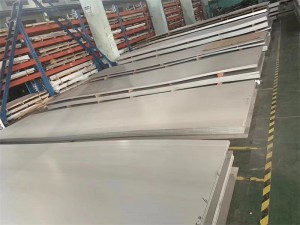
304 stainless steel plate
Chemical composition
304 stainless steel brand: 0Cr18Ni9 (0Cr19Ni9) 06Cr19Ni9 S30408
Chemical composition :C: ≤0.08, Si: ≤1.0 Mn: ≤2.0, Cr: 18.0 ~ 20.0, Ni: 8.0 ~ 10.5, S: ≤0.03, P: ≤0.035 N≤0.1.
304L
304L is more resistant to corrosion and 304L contains less carbon.
304 widely used, with good corrosion resistance, heat resistance, low temperature strength and mechanical characteristics; Stamping bending and other hot processing good, no heat treatment hardening phenomenon (non-magnetic, using temperature -196°C~800°C).
304L has excellent resistance to grain boundary corrosion after welding or stress removal; In the absence of heat treatment, it can also maintain good corrosion resistance, and the service temperature is -196°C-800°C.
Basic information
According to the process, it can be divided into two types: hot rolled and cold rolled. According to the structure characteristics of steel, it can be divided into five types: austenitic type, austenitic – ferritic type, ferritic type, martensitic type and precipitation-hardened type. Requirements can withstand oxalic acid, sulfuric acid-ferric sulfate, nitric acid, nitric acid-hydrofluoric acid, sulfuric acid-copper sulfate, phosphoric acid, formic acid, acetic acid and other acids corrosion, widely used in chemical, food, medicine, paper making, petroleum, atomic energy and other industries, as well as construction, kitchenware, tableware, vehicles, household appliances and all kinds of parts.
Stainless steel plate surface smooth, high plasticity, toughness and mechanical strength, acid, alkaline gas, solution and other media corrosion resistance. It is an alloy steel that does not rust easily, but not absolutely.
Stainless steel plate according to the method of hot rolled and cold rolled two kinds, including thickness 0.02-4 mm thin cold plate and 4.5-100 mm medium thick plate.
In order to ensure that the mechanical properties such as yield strength, tensile strength, elongation and hardness of all kinds of stainless steel plates meet the requirements, the steel plates must undergo annealing, solution treatment, aging treatment and other heat treatment before delivery. 05.10 88.57.29.38 Special symbol
Corrosion resistance of stainless steel mainly depends on its alloy composition (chromium, nickel, titanium, silicon, aluminum, etc.) and internal organizational structure, the main role is chromium element. Chromium has high chemical stability, can form passivation film on the surface of steel, so that the metal is isolated from the outside world, protect the steel plate from oxidation, increase the corrosion resistance of the steel plate. After the passivation film is destroyed, the corrosion resistance decreases.
Drawing property
Dry mill drawing
The most common filament and short silk on the market, 304 stainless steel plate after processing such surface, shows a good decorative effect, can meet the requirements of general decorative materials. Generally speaking, 304 stainless steel can form good results after a scrub. Due to the low cost, simple operation, low processing cost and wide application of this kind of processing equipment, it has become a necessary equipment for processing center. So most processing centers can provide long wire and short wire frosted board, 304 steel accounted for more than 80%.
Oil grinding wire drawing
304 series stainless steel after oil grinding reflects the perfect decorative effect, widely used in elevator, home appliances and other decorative panels. Cold rolled 304 stainless steel can generally achieve good results after a scrub pass, there are some processing centers on the market can provide hot rolled stainless steel oil scrub processing, its effect and cold rolled oil grinding comparable. Oil-based drawing also has long silk and short silk. Elevator decoration generally uses filament, and all kinds of small household appliances, kitchenware and other two kinds of grain have a choice
-
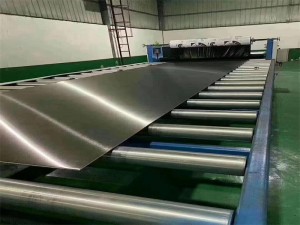
201 Stainless Steel
Product introduction
Mainly used for decorative pipe, industrial pipe, some shallow tensile products.201 stainless steel plate has the ability to resist general corrosion similar to the unstable nichcr 304. Prolonged heating of 201 stainless steel plates in the chrome-carbide degree temperature range may affect alloy 321 stainless steel plates and 347 in harsh corrosive media. 201 Stainless steel plates are mainly used for high temperature applications, which require the material to have strong sensitization resistance to prevent intergranular corrosion at lower temperatures.
Chemical composition
Chemicai composition(WT%)
(C) Carbon :≤0.15
(Si) Silicon :≤0.75
(Mn) Manganese :5.5 ~ 7.50
(Cr) Chromium :16.0 to 18.0
(N) Nitrogen :≤0.25
(Ni) nickel :3.50 ~ 5.50
(P) Phosphorus :≤0.060
(S) Sulfur :≤0.030
Physical property
Tensile strength :100,000 to 180,000 psi
Yield strength :50,000 to 150,000 psi
Density :.280lbs/cubic inch(density 7.93g/cm3)
Usage
Used in chemical, coal and petroleum industries with high corrosion resistance to grain boundaries, outdoor machines, heat-resistant parts of building materials and parts with difficulty in heat treatment;
1. Oil exhaust gas combustion pipeline;
2. Engine exhaust pipe;
3. Boiler shell, heat exchanger, heating furnace components;
4. Diesel engine muffler components;
5. Boiler pressure vessel;
6. Chemical transport truck;
7. Expansion joint;
8. Spiral welded pipe for furnace pipe and dryer
-

Quilted seamless pipe
Production specification:
Outer diameter of steel pipe 12-377
Steel pipe wall thickness of 2-50
Common material:
10# 0.07~0.13 0.17~0.37 0.35~0.65 ≤0.035 ≤0.035
20# 0.17~0.23 0.17~0.37 0.35~0.65 ≤0.035 ≤0.035
35# 0.32~0.39 0.17~0.37 0.35~0.65 ≤0.035 ≤0.035
45# 0.42~0.50 0.17~0.37 0.50~0.80 ≤0.035 ≤0.035
40cr 0.37~0.44 0.17~0.37 0.50~0.80 ≤0.035 ≤0.035 0.08~1.10
25Mn 0.22~0.2 0.17~0.37 0.70~1.00 ≤0.035 ≤0.035 ≤0.25
37Mn5 0.30~0.39 0.15~0.30 1.20~1.50 ≤0.015 ≤0.020
Introduction:
Quilted seamless pipe is a kind of high precision steel pipe material after cold drawing or hot rolling. Because there is no oxide layer on the inner and outer walls of precision steel pipe, [1] under high pressure without leakage, high precision, high finish, cold bending without deformation, flaring, flattening without cracks and so on, it is mainly used for the production of pneumatic or hydraulic components, such as cylinders or cylinders, which can be seamless. The chemical composition of quilted seamless tube is carbon C, silicon Si, manganese Mn, sulfur S, phosphorus P, chromium Cr
Quilted seamless pipe adopts processing technology
The quilted seamless pipe is processed by rolling. Because of the residual compressive stress on the surface layer, it is helpful to close the micro cracks on the surface and prevent the expansion of erosion. It can improve the surface corrosion resistance and delay the generation or expansion of fatigue cracks, so as to improve the fatigue strength of quilted steel pipe. By rolling forming, a cold working hardening layer is formed on the rolling surface, which reduces the elastic and plastic deformation of the contact surface of the grinding pair, thus improving the wear resistance of the inner wall of the quilted steel pipe and avoiding the burn caused by grinding. After rolling, the reduction of surface roughness can improve the fit property.
Rolling machining is a kind of chip free machining. At normal temperature, the plastic deformation of metal is used to flatten the microscopic roughness of the workpiece surface so as to achieve the purpose of changing the surface structure, mechanical characteristics, shape and size. Therefore, this method can achieve the two purposes of polishing and strengthening at the same time, which is unable to do grinding.
No matter what kind of processing method is used to process, there will always be fine convex and concave uneven knife marks on the surface of the parts, and the phenomenon of staggered peaks and valleys,
Rolling processing principle: It is a kind of pressure finishing processing, is the use of metal in the normal temperature state of cold plastic characteristics, the use of rolling tools to exert a certain pressure on the workpiece surface, so that the workpiece surface metal plastic flow, fill into the original residual low concave trough, and achieve the workpiece surface roughness value reduced. Due to the plastic deformation of the rolled surface metal, the surface tissue cold hardening and grain thinning, the formation of dense fiber, and the formation of residual stress layer, hardness and strength, thus improving the wear resistance, corrosion resistance and compatibility of the workpiece surface. Rolling is a plastic machining method without cutting.
Quilted seamless pipe several advantages:
1, improve the surface roughness, roughness can basically reach Ra≤0.08µ m or so.
2, correct roundness, ellipticity can be less than 0.01mm.
3, improve the surface hardness, the force deformation is eliminated, hardness increase HV≥4°
4, after processing residual stress layer, improve the fatigue strength by 30%.
5, improve the quality of fit, reduce wear, prolong the service life of parts, but the processing cost of parts is reduced.
-
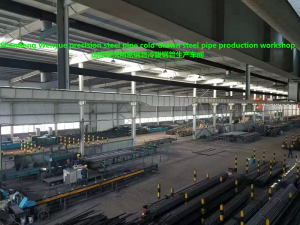
Cold-drawn seamless steel pipe
Production specification:
Outer diameter of steel pipe 12-377
Steel pipe wall thickness of 2-50
Product introduction:
In order to obtain smaller size and better quality small-diameter seamless steel pipes, it is necessary to use cold rolling, cold drawing or a combination of both methods. Cold rolling is usually carried out on a two-high mill, in which steel pipe is rolled in an annular pass consisting of a circular groove of variable section and a stationary conical head. Cold drawing is usually carried out in 0.5 ~ 100T single chain or double chain cold drawing machine.
High-quality carbon structural steel cold-drawn seamless pipe, mainly made of No. 10, No. 20, No. 35, No. 45 steel, in addition to ensure chemical composition and mechanical properties to do hydraulic test, flange, flaring, flattening and other tests.
Calculation formula for weight of cold-drawn seamless steel pipe
 OD – wall thickness)* Wall thickness *0.02466=kg/ m (weight per meter)
OD – wall thickness)* Wall thickness *0.02466=kg/ m (weight per meter)Cold drawing material:
10#, 20#, 35#, 45#, q345b, 40cr, 42crmo, 35crmo, 30crmo and other materials
-
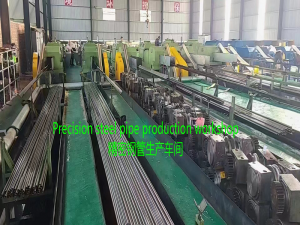
Precision steel pipe
Product introduction:
Precision steel pipe high size, high precision, pipe inside and outside surface finish, after heat treatment of steel pipe inside and outside the surface are no oxide film, steel pipe flaring, flattening without cracks, cold bending without deformation, and can withstand high pressure, can make a variety of complex deformation and mechanical deep processing.
The main production of steel pipe brands: 10#, 20#, 35#, 45#, 40cr, 42crmo, 16mn, etc
Production specification:
Outer diameter of steel pipe 12-159
Steel pipe wall thickness of 2-30
Basic use:
Precision steel pipe is widely used in automobiles, motorcycles, electric vehicles, petrochemical, electric power, ships, aerospace, bearings, pneumatic components, medium and low pressure boiler seamless steel pipe and other fields, can also be applied to steel bar sleeve, bearings, hydraulic, mechanical processing and other fields!
Production process:
The production process of precision steel pipe is the same as that of ordinary seamless pipe, that is, there is a final pickling and cold rolling procedure.
Precision steel pipe process flow
Tube billet heating – inspection – skin – - – perforation, pickling passivation, grinding – oil lubrication dry – cold rolled – to – cut head – inspection, identification, finished product packaging
-
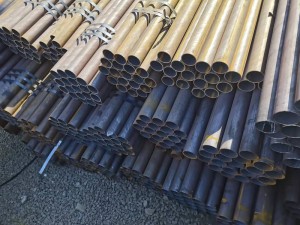
10# Seamless steel pipe
Production specification:
Outer diameter of steel pipe 20-426
Steel pipe wall thickness of 20-426
Chemical composition:
● No. 10 seamless steel pipe chemical composition:
Carbon C: 0.07~0.14″ silicon Si: 0.17 ~ 0.37 Manganese Mn: 0.35 ~ 0.65 Sulfur S: ≤0.04 Phosphorus P: ≤0.35 chromium Cr: ≤0.15 Nickel Ni: ≤0.25 Copper Cu: ≤0.25
Mechanical property:
Mechanical properties of No. 10 seamless steel pipe:Tensile strength σb (MPa) : ≥410(42) Yield strength σs (MPa) : ≥245(25) elongation δ5 (%) : ≥25 sectional shrinkage (%) : ≥5, hardness: unheated,≤156HB, sample size: 25mm.
High quality carbon structural steel:
No. 10 seamless steel pipe does not contain other alloy elements (except residual elements) except carbon (C) element and a certain amount of silicon (Si) for deoxidation (generally not more than 0.40%), manganese (Mn) (generally not more than 0.80%, up to 1.20%) alloy elements.
Such steel must have both chemical composition and mechanical properties. The contents of sulfur (S) and phosphorus (P) are generally controlled below 0.035%. If it is controlled below 0.030%, it is called high quality steel, and “A” should be added after the grade, such as 20A; If P is controlled below 0.025% and S is controlled below 0.020%, it is called extra high quality steel, and “E” should be added after the grade to show the difference. For other residual alloying elements brought into steel by raw materials, such as chromium (Cr), nickel (Ni), copper (Cu), etc., the content of Cr≤0.25%, Ni≤0.30%, Cu≤0.25%. Some brands of manganese (Mn) content up to 1.40%, known as manganese steel.
No. 10 seamless steel pipe weight calculation formula :[(outer diameter - wall thickness)* wall thickness]*0.02466=kg/ m (weight per meter)
-

Q345B Seamless tube
Production specification:
Outer diameter of steel pipe 20-426
Steel pipe wall thickness of 20-426
Main characteristics:
Good comprehensive mechanical properties, weldability, cold, hot working properties and corrosion resistance, with good low temperature toughness
Product application:
Ships, boilers, pressure vessels, oil storage tanks, Bridges, power plant equipment, lifting machinery and other welding structures with higher loads
-

35CrMo alloy steel pipe
Production specification:
Outer diameter of steel pipe 20-426
Steel pipe wall thickness of 20-426
Product introduction:
For example, 40Cr. (Carbon content of 35CrMo alloy steel pipe is 0.32~0.40, silicon 0.17~0.37, manganese 0.40~0.70, molybdenum 0.15~0.25, chromium 0.80~1.10)
② The main alloying elements in steel, except some microalloying elements, are generally expressed by several percent. When the average alloy content is less than 1.5%, only the element symbol is generally marked in the steel number, but not the content. However, in special cases, it is easy to confuse, the number “1″ can be marked after the element symbol, such as the steel number “12CrMoV” and “12Cr1MoV”, the chromium content of the former is 0.4-0.6%, and that of the latter is 0.9-1.2%. Everything else is the same. When the average alloying element content ≥1.5%, ≥2.5%, ≥3.5%…… “, the element symbol should be marked after the content, can be expressed as 2, 3, 4…… Etc. For example, 18Cr2Ni4WA.
③ Alloy elements such as vanadium V, titanium Ti, aluminum AL, boron B and rare earth RE in steel belong to microalloying elements. Although the content is very low, they should still be marked on the steel number. For example, in 20MnVB steel. Vanadium is 0.07-0.12% and boron is 0.001-0.005%.
④ “A” should be added at the end of the steel number of high-grade steel to distinguish it from general high-quality steel.
⑤ Special purpose alloy structural steel, steel number prefix (or suffix) represents the purpose of the steel symbol. For example, the 30CrMnSi steel specially used for riveting screws is expressed as ML30CrMnSi.
Alloy tube and seamless tube both have relations and differences, can not be confused.
Alloy pipe is steel pipe in accordance with the production material (that is, material) to define, as the name suggests is made of alloy pipe; And seamless pipe is steel pipe in accordance with the production process (seamless) to define, different from seamless pipe is welded pipe, including straight seam welded pipe and spiral pipe.
Manufacturing technology:
1. Hot rolling (extrusion seamless steel pipe) : round tube blank → heating → perforating → three-high diagonal rolling, continuous rolling or extrusion → stripping → sizing (or reducing) → cooling → straightening → hydrostatic test (or inspection) → marking → storage
2. Cold-drawn (rolled) seamless steel pipe: round tube blank → heating → perforation → heading → annealing → pickling → oiling (copper plating) → multi-pass cold drawing (cold rolling) → blank tube → heat treatment → straightening → hydrostatic test (inspection) → marking → storage
-
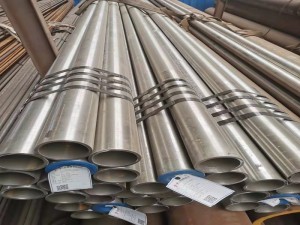
30CrMo alloy steel pipe
Production specification:
Outer diameter of steel pipe 20-426
Steel pipe wall thickness of 20-426
Product introduction:
① The two digits at the beginning of the steel number indicate the carbon content of the steel, with the average carbon content of a few thousand, such as 40Cr, 30CrMo alloy steel pipe
② The main alloying elements in steel, except some microalloying elements, are generally expressed by several percent. When the average alloy content is less than 1.5%, only the element symbol is generally marked in the steel number, but not the content. However, in special cases, it is easy to confuse, the number “1″ can be marked after the element symbol, such as the steel number “12CrMoV” and “12Cr1MoV”, the chromium content of the former is 0.4-0.6%, and that of the latter is 0.9-1.2%. Everything else is the same. When the average alloying element content ≥1.5%, ≥2.5%, ≥3.5%…… “, the element symbol should be marked after the content, can be expressed as 2, 3, 4…… Etc. For example, 18Cr2Ni4WA.
③ Alloy elements such as vanadium V, titanium Ti, aluminum AL, boron B and rare earth RE in steel belong to microalloying elements. Although the content is very low, they should still be marked on the steel number. For example, in 20MnVB steel. Vanadium is 0.07-0.12% and boron is 0.001-0.005%.
④ “A” should be added at the end of the steel number of high-grade steel to distinguish it from general high-quality steel.
⑤ Special purpose alloy structural steel, steel number prefix (or suffix) represents the purpose of the steel symbol. For example, the 30CrMnSi steel specially used for riveting screws is expressed as ML30CrMnSi.
Manufacturing technology:
1. Hot rolling (extrusion seamless steel pipe) : round tube blank → heating → perforating → three-high diagonal rolling, continuous rolling or extrusion → stripping → sizing (or reducing) → cooling → straightening → hydrostatic test (or inspection) → marking → storage
2. Cold-drawn (rolled) seamless steel pipe: round tube blank → heating → perforation → heading → annealing → pickling → oiling (copper plating) → multi-pass cold drawing (cold rolling) → blank tube → heat treatment → straightening → hydrostatic test (inspection) → marking → storage
-
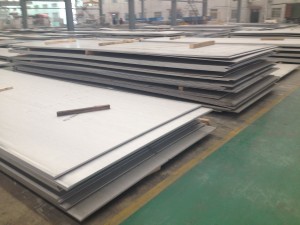
440 stainless steel plate 440stainless steel coil
Stainless steel plate has smooth surface, high plasticity, toughness and mechanical strength, and is resistant to corrosion of acid, alkaline gas, solution and other media. It is a kind of alloy steel that is not easy to rust, but it is not absolutely rust free. Stainless steel plate refers to the steel plate resistant to the corrosion of weak media such as atmosphere, steam and water, while acid resistant steel plate refers to the steel plate resistant to the corrosion of chemical etching media such as acid, alkali and salt. Stainless steel plate has a history of more than one century since it came out in the early 20th century.
-

410 stainless steel plate, 410 stainless steel coil
Stainless steel plate has smooth surface, high plasticity, toughness and mechanical strength, and is resistant to corrosion of acid, alkaline gas, solution and other media. It is a kind of alloy steel that is not easy to rust, but it is not absolutely rust free. Stainless steel plate refers to the steel plate resistant to the corrosion of weak media such as atmosphere, steam and water, while acid resistant steel plate refers to the steel plate resistant to the corrosion of chemical etching media such as acid, alkali and salt. Stainless steel plate has a history of more than one century since it came out in the early 20th century.